John Berry (Royal Navy officer)
Admiral Sir John Berry (1635 – 14 February 1689 or 1690) was an English naval officer of the Royal Navy, and was in 1675 the captain of the annual convoy to Newfoundland that took place during the years of the colony's founding. Berry's advocacy of the right of the small number of settlers to remain in Newfoundland, which was opposed by the British Committee for Trade and Plantations, was an important factor in determining the future course of European settlement in Newfoundland.
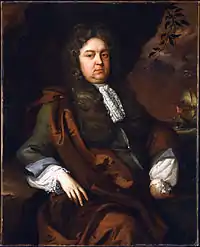
Origins
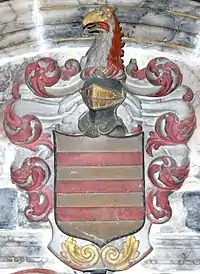
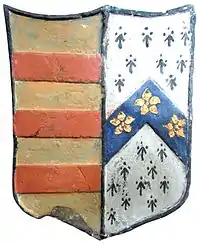
Berry was born at Knowstone, North Devon, the second of seven sons of Rev. Daniel Berry (1609–1654), vicar of Knowstone cum Molland in North Devon by his wife Elizabeth Moore, daughter of Sir John Moore of Moor Hayes in the parish of Cullompton, Devon.[2][3] Daniel Berry held the benefice freehold and had inherited it from his father, but was violently deprived of his position and livlihood during the Civil War. Sir John in 1684 erected a mural monument in Molland Church, which survives, which relates the injustices suffered by his father in this regard. Daniel's eldest two sons, thus deprived of their prospective patrimony, sought a career at sea, as was common for West-Country youths seeking their fortunes. The Berry family had been established from the reign of King Edward I (1272–1307)[4] near the north coast of Devon as lords of the manor of Nerbert or Narbor, which manor took their name and became known as Berry Narbor, today known as Berrynarbor. Younger branches settled at Braunton, Eastleigh and Chittlehampton,[5] but from which branch the Knowstone family descended is not recorded in the Heraldic Visitations of Devon.[6]
Monument to father at Molland
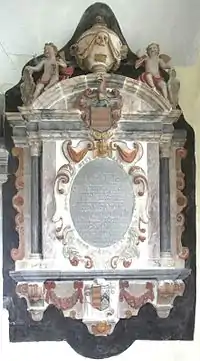
In Molland Church, Devon, exists a mural monument erected in 1684 by Sir John Berry to his father Rev. Daniel Berry (1609–1654). It is inscribed thus: Under this monument lieth the body of Daniel Berry, B of D sometime minister of this church and that of the parish of Knowstone wherein he was born, who for his zeal in the support of the Church of England and loyalty to that martyr'd King Charles I was first sequestrated by the then rebels and ever after persecuted 'till he died, being the 18th day of Mar. 1653/4 and of his age 45, leaving behind him 7 sons, Robert, John, Daniel, Nathaniel, Anthony, Philip and Thomas, and two daughters Elizabeth and Anne, by Elizabeth his wife, daughter of John Moore of Moorehays, Esq., who died 13 Octob. 1663, and lieth here likewise interred. The second of their sons, who received the honour of knighthood from his present Majesty K. Ch.2 for his long and many good services at sea, honouring the memory of all orthodox and loyal men of the late times and out of a pious regard of his father's sufferings, erected this monument, 17 day of Jul. AD 1684"
Marriage
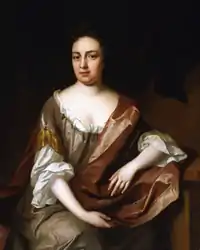
Berry married Rebecca Ventris (d.1696), of the Ventris family of Granhams, Great Shelford, Cambridgeshire, as identified from the arms of Ventris shown on her monument in Stepney Church, London.[7] The Heralds' Visitation of Cambridgeshire gives only a short pedigree of the Ventris family ending before Rebecca's birth, but gives the family's arms as: Azure, a dolphin between two bendlets wavy an annulet argent. She may have been a sister of Sir Peyton Ventris (1645–1691), eldest surviving son of Edward Ventris (d.1649), barrister. Her portrait was painted by Michael Dahl to form a pair with that of her husband.[8] The marriage was without progeny. Rebecca married secondly Thomas Elton of Stratford Bow, London. Her mural monument exists on the east wall of the chancel of St Dunstan's Church, Stepney, and displays an heraldic escutcheon showing the arms of Elton (Paly of six, on a bend three mullets) impaling Ventris. It is inscribed with the following verse recorded by Daniel Lysons in 1795:[9]
"Come ladies ye that would appear,
Like angels fine come dress you here,
Come dress you at this marble stone,
And make this humble grave your own,
Which once adorn'd as fair a mind,
As ere yet lodged in woman kind.
So she was dress'd whose humble life,
Was free from pride was free from strife,
Free from all envious brawls and jars,
Of human life the civil wars,
These ne'er disturb'd her peaceful mind,
Which still was gentle still was kind.
Her very looks her garb her mien,
Disclos'd the humble soul within.
Trace her through every scene of life,
View her as widow virgin wife,
Still the same humble she appears,
The same in youth the same in years,
The same in low and high estate,
Ne'er vex'd with this ne'er mov'd with that.
Go ladies now and if you'd be
As fair as great and good as she,
Go learn of her humility."
Monument at Stepney
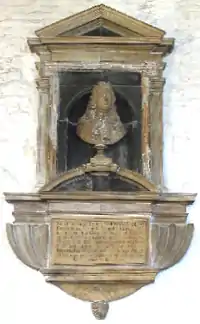
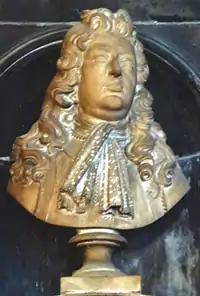
A mural monument to Sir John Berry exists in St Dunstan's Church, Stepney, London, on the north wall, which he ordered to be erected at a cost of no less than £150. Prince described the monument thus:[10] "It is all of white marble of about 10 foot in height and 5 in breadth finely polished. In a nich in the middle stands on a pedestal the effigies[11] of Sir John cut with a campaign wig and a cravat in pure alabaster. Over his head are the arms of his family, underneath on a table of white marble is the following epitaph in black letters:[12]
Ne id nescias lector D(ominus) Joannes Berry Devoniensis dignitate Equestri clarus mari non tantum imperator de rege et patria quod et Barbari norunt bene meritus magnam ob res fortiter gestas adeptus gloriam Famae satur post multas reportatas victorias cum ab aliis vinci non potuit Fatis cessit 14 Febr 1689[13] baptizatus 7 Jan 1635" ("Lest thou should not know, O reader, the famed Sir John Berry of Devon, with dignity of a knight, not just ruler of the sea (as well know too the Barbaries) having gained from King and Country well-deserved great glory on account of matters happily conducted, satiated with the glory of fame, after many victories brought home, as with others, was not able to defeat the Fates. He died 14 February 1689, was baptised 7 January 1635")
The monument survives, but no longer the pristine white of Prince's description but covered with a yellowish-brown patina. No trace survives of the arms described by Prince.
Sources
- Prince, John (d.1723), Worthies of Devon, 1810 edition, London, pp. 68–73, biography of Sir John Berry
Further reading
References
- Philip Mould Historical Portraits Picture Archive
- Prince, John, Worthies of Devon, 1810 edition, pp.68–73, biography of Sir John Berry
- Vivian, Lt.Col. J.L., (Ed.) The Visitations of the County of Devon: Comprising the Heralds' Visitations of 1531, 1564 & 1620, Exeter, 1895, p.573, pedigree of Moore
- Risdon, Tristram, Survey of Devon, 1810 edition, p.347
- Vivian, pp.74–80, pedigree of Berry
- Vivian, pp.74–80, pedigree of Berry, in which no mention is made of the Berry family of Knowstone
- Daniel Lysons, The Environs of London, Volume 3: County of Middlesex: Stepney, 1795
- Generally believed to be portrait of Lady Berry, but stated by "Philip Mould Historical Portraits Picture Archive" to represent one of Sir John Berry's two sisters Elizabeth or Anne (as listed in John Prince's biography), due to the sitter being deemed "middle aged" and therefore too old to be the wife whom Sir John suggested in a 1689 codicil to his will might bear more children
- Daniel Lysons,1795' 'Stepney', The Environs of London: volume 3: County of Middlesex (1795), pp. 418–488. URL: http://www.british-history.ac.uk/report.aspx?compid=45447
- Quoted by Prince, Worthies of Devon, p.73, also by Daniel Lysons, The Environs of London, Vol.3, Middlesex, Stepney, 1795
- Effigies, Latin, "likeness, portrait"
- Corrected as per existing monument
- 1689 per monument, Prince states in error 1691
- "John Berry". Dictionary of Canadian Biography (online ed.). University of Toronto Press. 1979–2016.